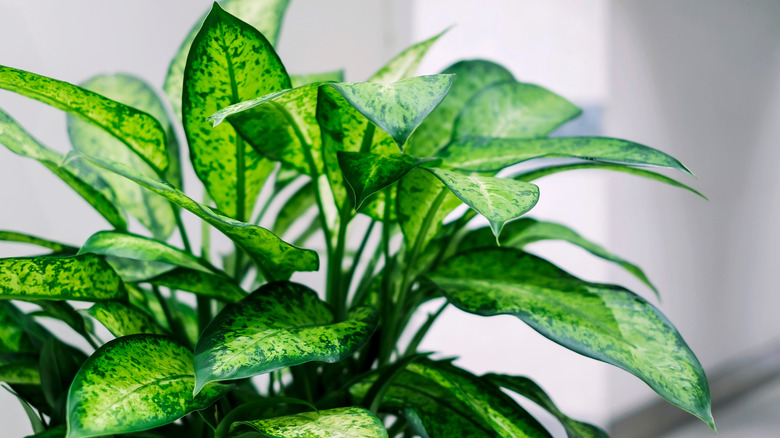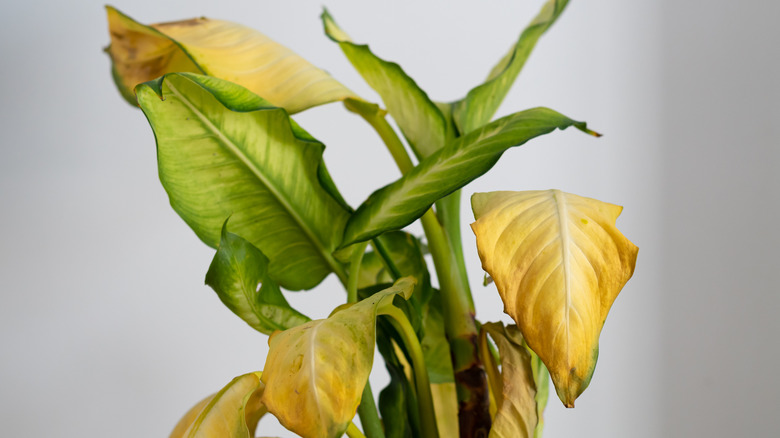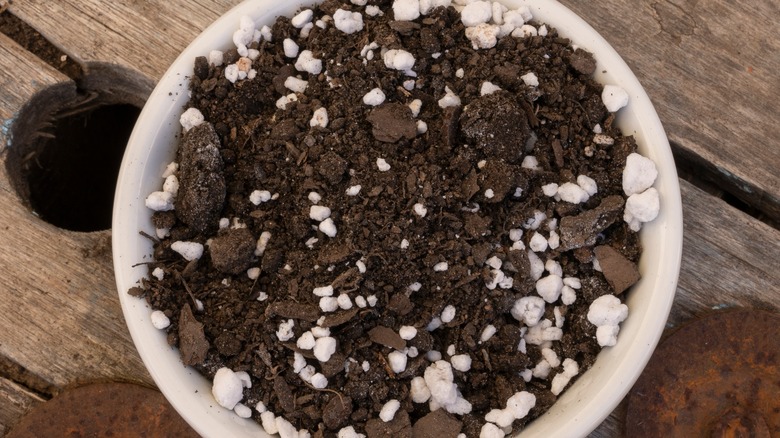The Best Way To Save An Overwatered Dieffenbachia Plant
When growing a Dieffenbachia plant, getting the watering right will set you up for success. This is an easy-care and long-lasting houseplant with lots of beautifully variegated foliage. It's a good idea to keep an eye on your plant's leaves because they tell you much about whether you have met its watering requirements. If the leaves start to fall off, it's a sure sign that you haven't been getting the right amounts. When this happens, observe whether the leaves are dried up, brittle, and brown or if they're yellow and leave behind a slippery residue on the stalk. If it is the latter, you're likely overwatering your plant, and it could be at risk of root rot (if it's not already infected).
There may still be time to save an overwatered Dieffenbachia plant, but you must act quickly to prevent root rot from spreading. Root rot occurs when the roots are exposed to wet conditions for too long and become suffocated due to the lack of oxygen. They die, and then decay and rot set in. This can happen due to overwatering, with soil not having enough time to dry out and allow air to circulate and the roots to breathe. It can also occur because of ill-draining soil or pots without sufficient drainage. Dormant fungus in the soil can also lead to root rot when it flourishes due to the prolonged moist environment overwatering provides.
How to check for and treat root rot from overwatering
The first signs of overwatering and root rot are wilting or yellowing leaves. A big clue is if just one stem of your Dieffenbachia plant is impacted. You might also notice an unpleasant smell when sitting near the infected plant, which is the bacteria in the soil. You'll have to check the plant's roots to know for sure. Take it out of the pot and massage the root ball. You'll know immediately if root rot is present because the roots will melt away in your fingers, making them easy to pull off the plant.
Unfortunately, you can't reverse root rot. The only way to treat the plant is to remove all dead and dying roots and any rotten parts on stems. Use disinfected tools, cleaning them after each cut to prevent the spread of the infection. Removing all signs of root rot is vital because the infection can spread to healthy roots after the plant has been repotted in fresh soil. So, clean the roots under lukewarm running water to avoid shocking the plant until all the mushy black bits have been washed off and you're left with firm, healthy roots. These don't have to be white. Get rid of the contaminated soil –- you don't want to risk infecting another plant with fungal spores — and then repot the plant in a clean container with fresh soil.
How to avoid overwatering your Dieffenbachia plant
If you have brought a new Dieffenbachia plant home from the store, or one has arrived in the mail, it's tempting to get it out of any packaging and water it immediately, but this would be a mistake. Overwatering a new plant is easy because the soil may already be waterlogged. This is because sometimes the soil is purposefully compacted down to protect the plant during transit, ensuring it stays in place and that the soil doesn't fall out while it is transported. But this means that water can't drain out, and if you add more water, you could suffocate the roots.
This is why it's crucial to continually assess whether a plant needs watering before you water it. This goes for new plants and the plants you already have in your home. To check, ignore the surface of the soil because water readily evaporates from here, and instead, check deeper down with your finger. Don't water the plant if the soil is still wet. If the soil is compacted, you may need to repot the plant to break up the soil, and it's a good idea to add perlite to improve water drainage and aeration. When the plant is ready to be watered, water thoroughly from the top until it seeps out through the bottom, and don't leave the plant standing in water.


